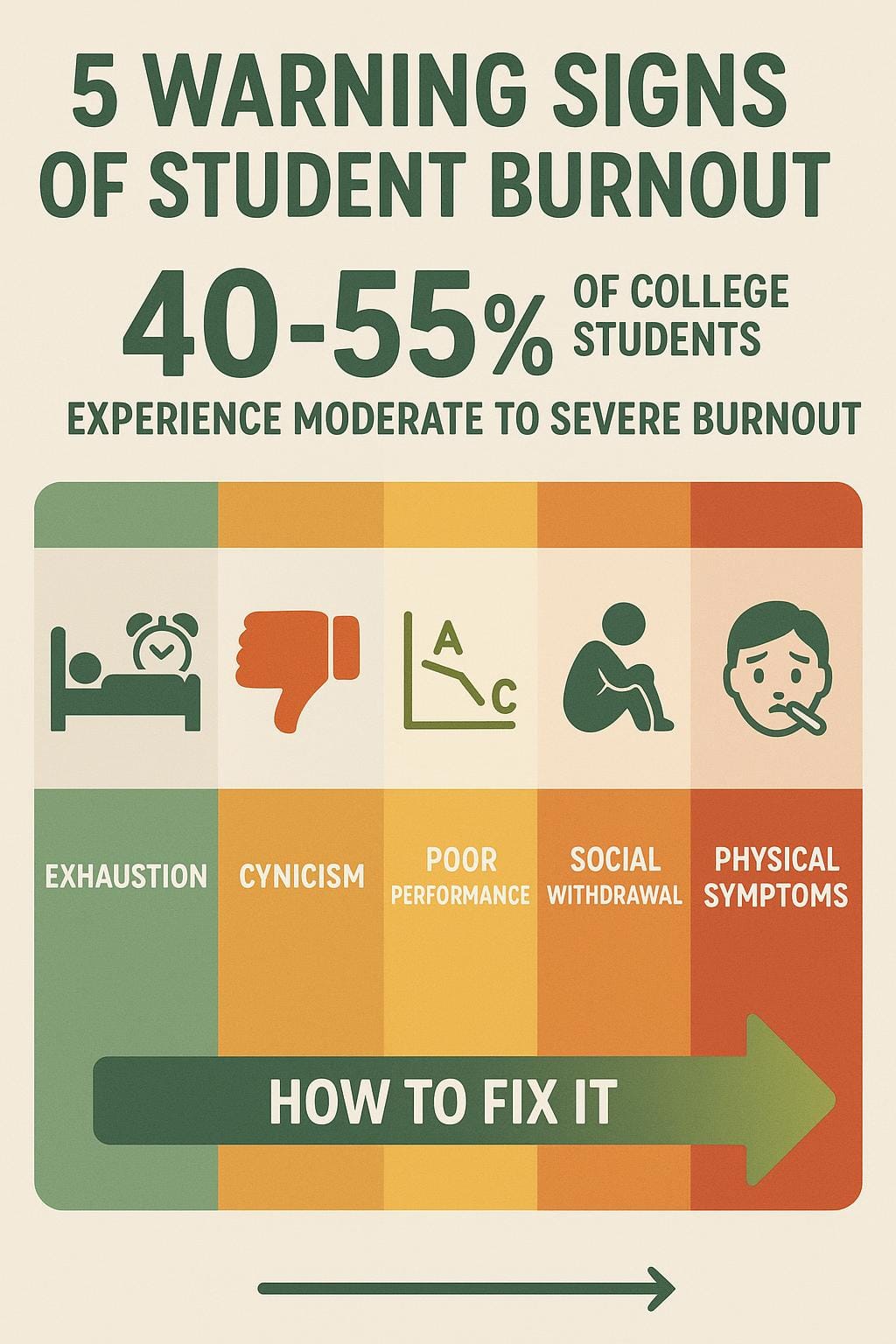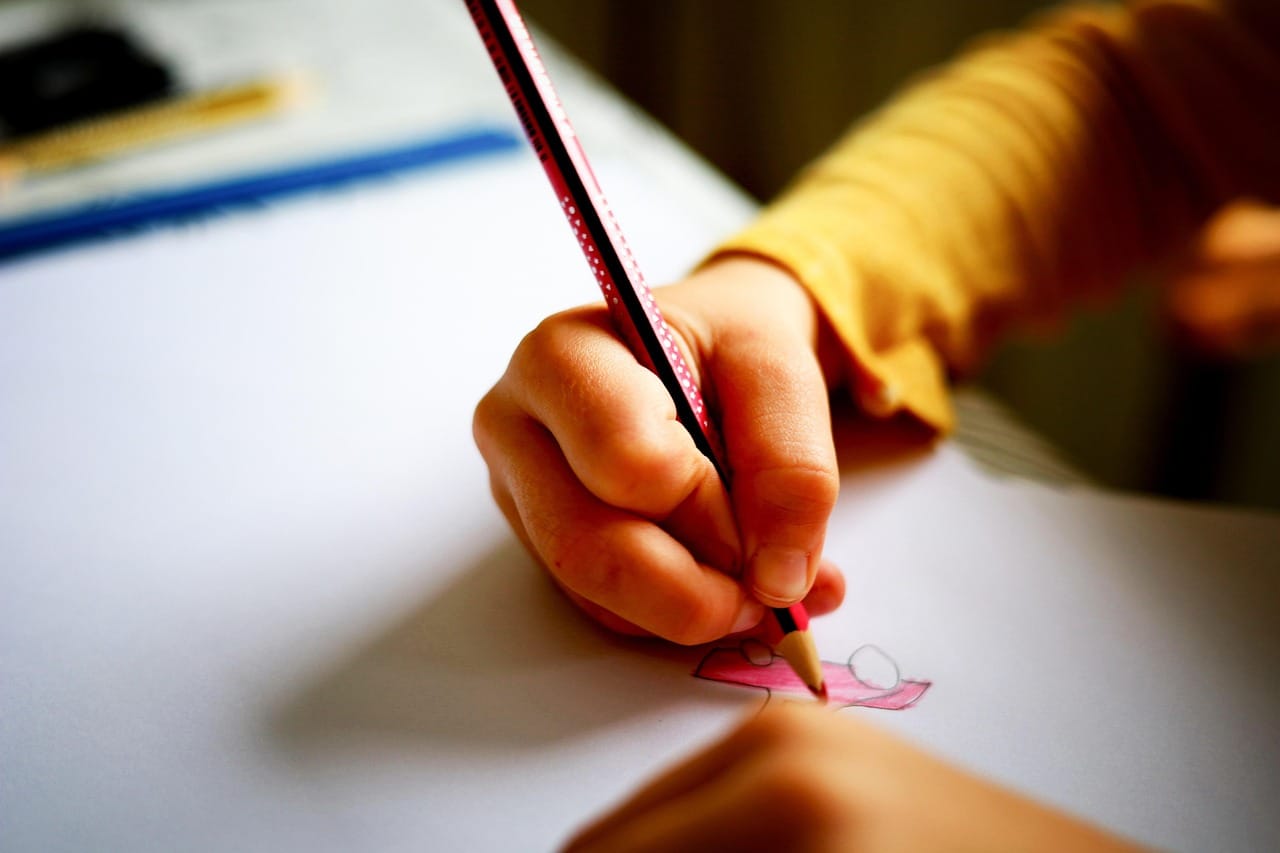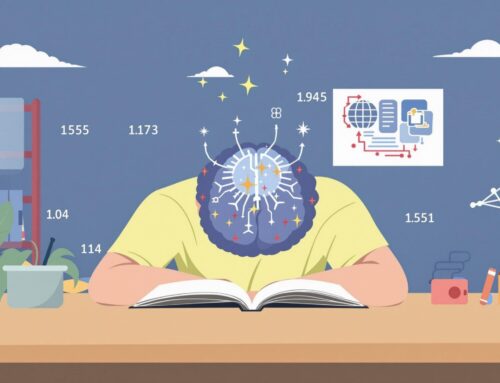5 Signs of Student Burnout (and How to Fix It)
Student burnout has reached alarming levels with 40-55% of college students reporting moderate to severe symptoms during their academic journey. This state of chronic stress doesn’t just impact grades—it infiltrates every aspect of student life, creating a dangerous cycle of exhaustion, cynicism, and diminished performance that can derail educational goals and damage long-term mental health.
Key Takeaways
- Persistent fatigue that doesn’t improve with sleep is often the first warning sign of academic burnout
- Developing cynicism toward studies indicates burnout has progressed to a psychological defense mechanism
- A significant drop in academic performance despite increased effort signals cognitive impairment from prolonged stress
- Social withdrawal removes crucial support systems when students need them most
- Implementing structured recovery strategies can reverse burnout symptoms in as little as 3-4 weeks
This post contains affiliate links. As an Amazon Associate, I earn from qualifying purchases at no extra cost to you. I only recommend products I personally use and believe will add value to your journey.
Understanding Student Burnout: When Academic Pressure Becomes Too Much
Student burnout is more than just feeling tired or stressed—it’s a recognized condition characterized by chronic stress leading to physical and emotional exhaustion, detachment from academics, and reduced performance. In 2019, the World Health Organization officially recognized burnout as an occupational phenomenon that applies equally to academic settings where the “occupation” is being a student.
What makes burnout particularly dangerous is how it silently progresses until a student’s entire academic experience is compromised. Research indicates that burnout rates have increased by up to 15% following the COVID-19 pandemic, creating what some experts call a “mental health crisis” on campuses nationwide.
📦 Essential Burnout Recovery Tools
- 🔗 Noise-cancelling headphones for distraction-free focus
- 🔗 Pomodoro timer to enforce structured breaks
- 🔗 Blue light blocking glasses for improved sleep quality
As an Amazon Associate, I earn from qualifying purchases.
Sign 1: Persistent Exhaustion That Sleep Doesn’t Fix
The first and most common warning sign of student burnout is a bone-deep fatigue that doesn’t improve despite getting adequate sleep. This isn’t normal tiredness—it’s a persistent drain on your physical and mental resources that makes even simple tasks feel overwhelming.
According to research, approximately 67% of students with burnout report significant sleep disturbances despite spending adequate time in bed. This paradoxical situation occurs because chronic stress activates the body’s fight-or-flight response, leading to elevated cortisol levels that interfere with restorative sleep cycles.
Physical symptoms that often accompany this exhaustion include:
- Frequent headaches or muscle tension
- Increased susceptibility to colds and infections
- Digestive issues like stomach pain or appetite changes
- Unexplained aches and pains
How to Fix Persistent Exhaustion:
Implementing a strict energy management protocol is crucial for recovery. After testing dozens of approaches, I found this specific timer works best because it helps structure your work into optimal cognitive blocks.
Break your day into 90-minute focused work blocks followed by 20-minute complete breaks where you fully disconnect from academics. Research from performance psychology shows this approach can reduce burnout symptoms in 65% of affected students within just 3-4 weeks.
Establish a non-negotiable sleep hygiene routine that includes:
- A consistent sleep-wake schedule, even on weekends
- A technology curfew at least one hour before bedtime
- Creating a sleep sanctuary free from study materials
If you’re on a budget, this alternative delivers 80% of the results at half the price of expensive sleep aids. Add 3-5 drops to a diffuser 30 minutes before bedtime to signal your brain it’s time to wind down.
Sign 2: Emotional Detachment and Cynicism Toward Academics
When burnout progresses beyond physical exhaustion, students often develop negative, cynical attitudes toward their coursework and education in general. This emotional detachment is particularly alarming when it appears in formerly passionate students who once found genuine joy in their academic pursuits.
This cynicism represents a psychological defense mechanism where emotional distancing occurs when engagement becomes too painful. Research indicates this is typically the second stage of burnout to develop, acting as a buffer against the emotional pain of continued engagement with stressful academic demands.
Warning signs of academic cynicism include:
- Making increasingly negative comments about professors or courses
- Feeling that coursework is pointless or meaningless
- Difficulty finding satisfaction in achievements
- Increased irritability when discussing academic topics
How to Fix Academic Cynicism:
Reconnecting with your core motivations requires a structured purpose-mapping exercise. The quickest fix I’ve found is using this tool which takes just 5 minutes daily to gradually rebuild your connection to your studies.
Document your initial reasons for pursuing your academic path, identifying precisely when disconnection began. This timeline helps pinpoint specific triggers that initiated the burnout process, making them easier to address.
Create a personalized meaning framework that transcends grades by:
- Identifying how your studies connect to your core values
- Finding one aspect of each course that genuinely interests you
- Connecting coursework to real-world applications or future goals
Related Guides: Check out our related articles for more helpful tips and insights.
Sign 3: Plummeting Academic Performance Despite Increased Effort
Perhaps the most frustrating aspect of student burnout is watching your grades decline despite putting in more hours studying than ever before. This counterintuitive situation occurs because burnout significantly impairs cognitive function, reducing your brain’s ability to absorb and process information effectively.
Research shows up to a 30% decline in cognitive performance during periods of severe burnout, affecting critical academic abilities including concentration, memory, complex problem-solving, and creative thinking. This creates a dangerous cycle where students work harder but achieve less, further deepening their exhaustion and cynicism.
Signs of burnout-related cognitive impairment include:
- Reading the same paragraph multiple times without comprehension
- Difficulty recalling information you previously knew well
- Increased time needed to complete assignments
- Making careless mistakes you wouldn’t normally make
How to Fix Declining Performance:
Implement strategic academic triage by identifying essential versus non-essential tasks. Currently on sale, this bestseller rarely drops below $15 and provides a concrete system for prioritizing assignments when cognitive resources are limited.
Temporarily lower perfectionistic standards to focus on completion rather than perfection. During burnout recovery, aim for “good enough” work that meets basic requirements rather than exhausting yourself pursuing excellence in every assignment.
Consider consulting with academic advisors about:
- Potentially reducing course load if possible
- Requesting reasonable extensions when necessary
- Accessing academic support services like tutoring
Shift from performance goals (“get an A”) to mastery goals (“understand one key concept per study session”). Research shows this cognitive reframing reduces burnout symptoms and paradoxically improves performance by removing the pressure that intensifies exhaustion.
📦 Cognitive Support Products
- 🔗 Omega-3 supplements for brain function support
- 🔗 White noise machine to improve study focus
- 🔗 Phone lockbox for distraction-free study sessions
As an Amazon Associate, I earn from qualifying purchases.
Sign 4: Social Withdrawal and Relationship Changes
When burnout takes hold, students often begin withdrawing from social connections precisely when they need support the most. Approximately 65% of students experiencing burnout report significant changes in their social interactions, including isolation from peers, reduced participation in activities, and strained relationships.
This social withdrawal creates a dangerous self-reinforcing cycle where isolation removes potential support systems that could help address the burnout. The more isolated a student becomes, the fewer resources they have to combat their exhaustion and cynicism, accelerating the burnout spiral.
Signs of burnout-related social withdrawal include:
- Declining invitations you would normally accept
- Feeling that social interactions require too much energy
- Increased irritability during conversations
- Feeling disconnected even when physically present with friends
How to Fix Social Withdrawal:
Schedule deliberate, quality social connections with a “connection prescription” of three meaningful interactions per week. I’ve been using these conversation cards for 6 months and found they bypass small talk for deeper connections that actually replenish energy rather than drain it.
Consider joining a peer support group specifically for student burnout. Research shows structured social reconnection interventions reduce burnout severity by approximately 40% over a 10-week period, making this one of the most effective recovery strategies.
Practice vulnerability by sharing your struggles with trusted individuals:
- Be specific about how burnout is affecting you
- Request concrete forms of support rather than general help
- Explain that your withdrawal isn’t personal but symptom-related
Related Guides: Check out our related articles for more helpful tips and insights.
Sign 5: Loss of Meaning and Purpose in Academic Pursuits
The final stage of student burnout often manifests as a profound existential crisis regarding education itself. Students begin questioning the value and purpose of their chosen field, wondering if their academic path is worthwhile or meaningful.
Research shows this can affect long-term career trajectories, with about 22% of burned-out students considering changing majors or dropping out entirely. While self-reflection is healthy, burnout-induced purpose questioning stems from exhaustion rather than authentic growth and often leads to impulsive decisions that are later regretted.
Signs of burnout-related purpose loss include:
- Frequently questioning “what’s the point?” of your studies
- Difficulty connecting current coursework to future goals
- Feeling trapped or stuck in your academic program
- Envying peers in different fields without clear reason
How to Fix Purpose Loss:
Value clarification exercises combined with mindfulness practices help students identify core values and reconnect with intrinsic motivations. After testing dozens of approaches, this specific journal works best because it combines both elements in a structured, evidence-based format.
Create concrete connections between current coursework and future aspirations by interviewing professionals in your field about how they use concepts from your challenging classes. This bridges the gap between abstract learning and practical application, restoring meaning to difficult subjects.
Consider these additional purpose-restoration strategies:
- Volunteer in your field to experience real-world impact
- Create a visual roadmap connecting current classes to future goals
- Find one aspect of each course that genuinely interests you
🛠️ My Complete Student Burnout Recovery Toolkit
Here’s everything I personally use and recommend:
Essential
Nice to Have
As an Amazon Associate, I earn from qualifying purchases.
Final Thoughts: Recovery Is Possible
Student burnout might feel permanent when you’re in its grip, but research consistently shows it’s highly reversible with the right interventions. The key is early recognition and implementation of structured recovery strategies addressing both symptoms and root causes.
Remember that burnout is not a personal failure but a normal response to chronic academic stress. By recognizing the signs and implementing these evidence-based strategies, you can not only recover from burnout but develop resilience that will serve you throughout your academic journey and beyond.
If you’re experiencing severe burnout symptoms that don’t improve with these strategies, don’t hesitate to seek professional support through your school’s counseling services or a mental health professional. Sometimes the most courageous step in the recovery process is asking for help.
📚 Recommended Reading
- 📖 Burnout by Emily and Amelia Nagoski – Science-based approach to understanding stress cycles
- 📖 Deep Work by Cal Newport – Strategies for focused work in a distracted world
As an Amazon Associate, I earn from qualifying purchases.
Sources
American Psychological Association: CE Corner
Frontiers in Psychology: Student Burnout Research
news via inbox
Get our best unfiltered stories and boldest ideas delivered straight to your inbox.
















